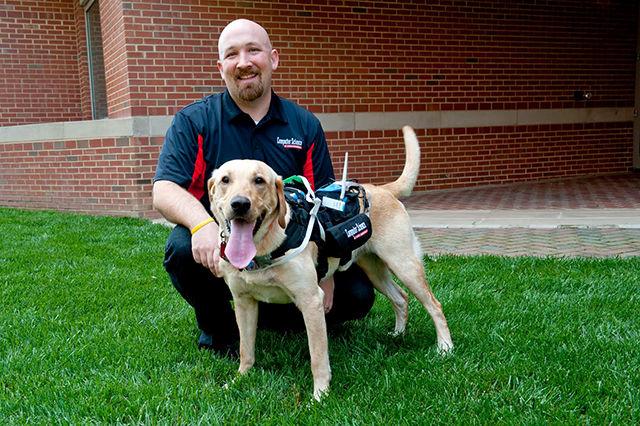Researchers at NC State have developed a new harness aimed at enhancing communication between dogs and humans. The new developments could create more effective training for service dogs and provide information about dogs’ emotional responses to different situations.
David Roberts, an assistant professor in computer science worked as the lead scientist on the project along with Alper Bozkurt, assistant professor in electrical and computer engineering, and Barbara Sherman, a clinical professor in the department of clinical sciences.
These three researchers first received funding for the project approximately 13 months ago from the National Science Foundation, and they are in the process of improving the current prototype.
The Cyber-Enhanced Working Dog harness includes a computer, several different sensors and vibration motors, and it can be controlled via computer or tablet.
Its two main functions are “passive sensing” and mediating communication with humans.
“The idea behind it is that dogs and humans communicate very differently,” Roberts said. “We wanted to set up a system to help us communicate more naturally with dogs.”
Passive sensing includes tracking a dog’s movements and emotional states. Accelerometers measure the dog’s lateral and rotational movements in three dimensions. Other sensors on the harness monitor the dog’s behavioral signals, including heart rate, respiratory rate and body temperature.
Monitoring a dog’s physiological and physical state could provide more insight into dogs’ behavior, according to Roberts.
“So much of their communication is through these behavioral changes,” Roberts said. “By looking at their posture and movement and physiology, we can start to decode some of these things.”
In addition to these sensors, other components can be added to the harness, including speakers, microphones cameras and air quality detectors. These could be valuable for service dogs, particularly in search and rescue missions.
“With these components, we can get a sense of the environment they are in and understand some of the potential hazards that they may encounter,” Roberts said.
The second objective of the researchers was to improve communication between dogs and humans.
According to Roberts, one of the main problems with training dogs is the difference in communication styles.
“Dogs have essentially no vocal communication,” Roberts said. “For the most part, 99 percent of their communications are postural … and it’s very difficult for humans to repeat the same command with the exact same inflection that dogs can understand.”
The harness aims to eliminate this problem by allowing dogs to respond to different vibrations from the harness, which can be initiated by a computer. The vibrations would be consistent, as opposed to human commands which vary each time they are given. Therefore, training dogs could become much more efficient.
“I think that better communication between the animal and the person would create a more effective team to do different jobs,” said Madison Serpan, a freshman studying engineering and a dog owner. “And better trained dogs always make it easier.”
In addition to the harness, the research team has been developing an automatic treat dispenser.
“Humans are inconsistent in delivering rewards,” Roberts said. The dispenser, however, distributes a treat as soon as sensors detect that the dogs has executed the desired trait, minimizing the inconsistency which can delay training.
Currently, the team is working to make the prototype smaller and improving its aesthetics. The harness currently weighs about four pounds, but making it smaller would make it easier for smaller dogs to wear. This may include making the battery smaller and adjusting different components.
The researchers are also considering using drone and robotic technology with the harness.
“It’s important to remember that we will never replace humans in this, but we can help address some of the issues humans have when communicating with dogs,” Roberts said.








